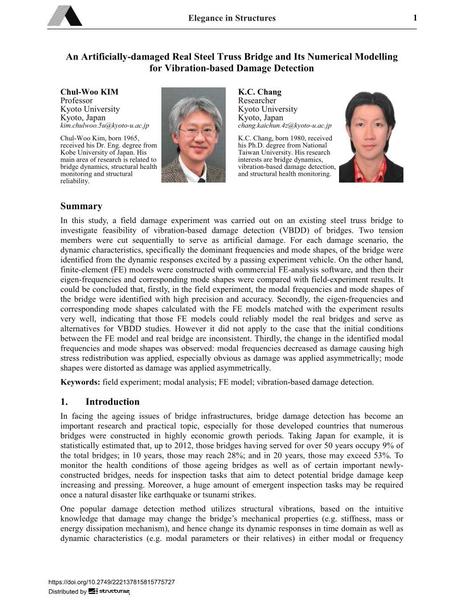An Artificially-damaged Real Steel Truss Bridge and Jts Numerical Modelling for Vibration-based Damage Detection

|
|
|||||||||||
Bibliografische Angaben
| Autor(en): |
Chul-Woo Kim
K. C. Chang |
||||
|---|---|---|---|---|---|
| Medium: | Tagungsbeitrag | ||||
| Sprache(n): | Englisch | ||||
| Tagung: | IABSE Conference: Elegance in structures, Nara, Japan, 13-15 May 2015 | ||||
| Veröffentlicht in: | IABSE Conference Nara 2015 | ||||
|
|||||
| Seite(n): | 436-437 | ||||
| Anzahl der Seiten (im PDF): | 8 | ||||
| Jahr: | 2015 | ||||
| DOI: | 10.2749/222137815815775727 | ||||
| Abstrakt: |
In this study, a field damage experiment was carried out on an existing steel truss bridge to investigate feasibility of vibration-based damage detection (VBDD) of bridges. Two tension members were cut sequentially to serve as artificial damage. For each damage scenario, the dynamic characteristics, specifically the dominant frequencies and mode shapes, of the bridge were identified from the dynamic responses excited by a passing experiment vehicle. On the other hand, finite-element (FE) models were constructed with commercial FE-analysis software, and then their eigen-frequencies and corresponding mode shapes were compared with field-experiment results. It could be concluded that, firstly, in the field experiment, the modal frequencies and mode shapes of the bridge were identified with high precision and accuracy. Secondly, the eigen-frequencies and corresponding mode shapes calculated with the FE models matched with the experiment results very well, indicating that those FE models could reliably model the real bridges and serve as alternatives for VBDD studies. However it did not apply to the case that the initial conditions between the FE model and real bridge are inconsistent. Thirdly, the change in the identified modal frequencies and mode shapes was observed: modal frequencies decreased as damage causing high stress redistribution was applied, especially obvious as damage was applied asymmetrically; mode shapes were distorted as damage was applied asymmetrically. |
||||
| Stichwörter: |
FE-Modell Modalanalyse
|
||||
